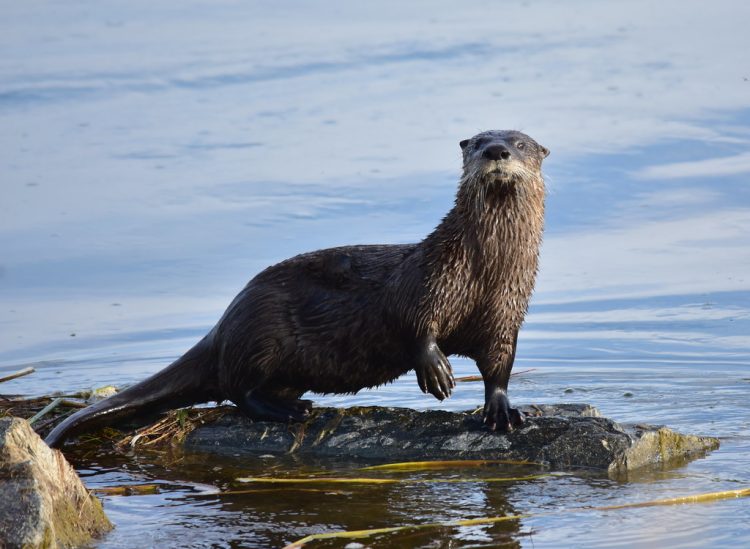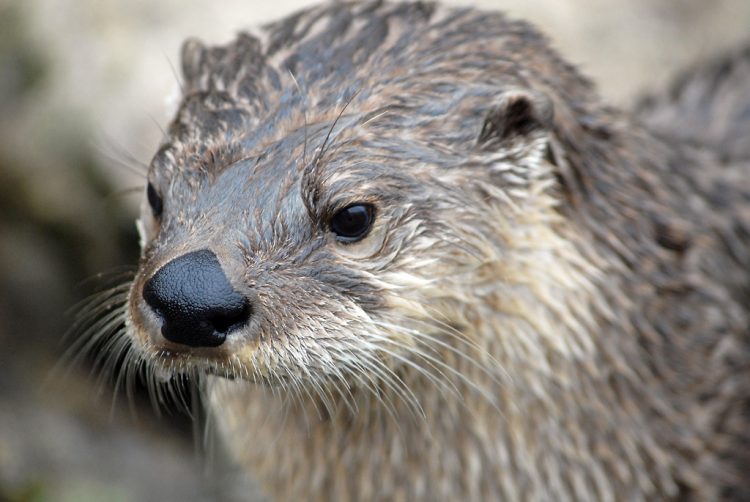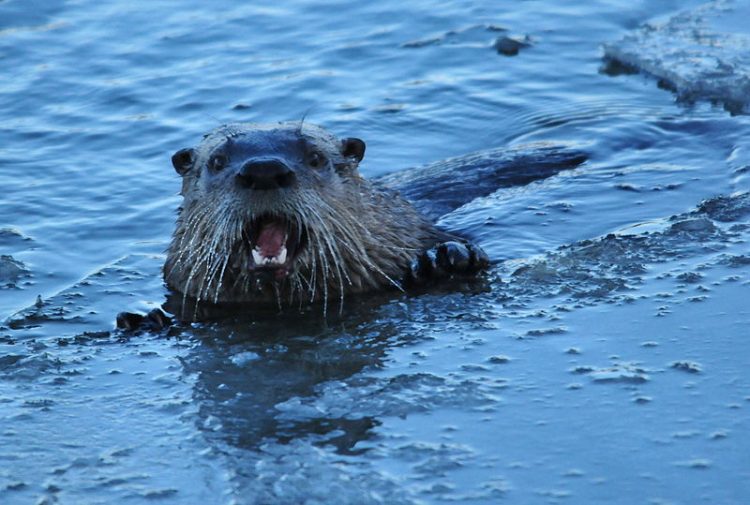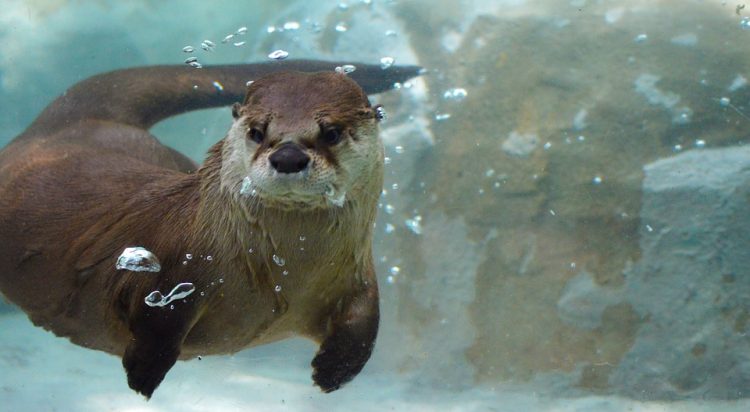Page Contents
River Otter Facts
Mustelids have long, slender bodies, short legs, and anal scent glands. Throughout the family, the male is usually larger than the female. The more terrestrial species of this family occupy various habitats and feed primarily on small mammals and birds. Mustelids that live around lakes and streams feed primarily on aquatic species such as fish, frogs, and invertebrates.
The northern river otter (Lutra canadensis) historically lived in or near lakes, marshes, streams, and seashores throughout much of the North American continent. Currently, many populations along the coastal United States and Canada are stable or increasing, but this species is rare or extirpated throughout much of the Midwestern United States.
The river otter dens on banks and hollow logs. Individuals range over large areas daily, feeding primarily on fish. The otters have few natural predators on land; they may be taken by coyotes, foxes, or dogs. Otters clean themselves frequently by rubbing and rolling on any dry surface.
Otters appear to undergo bradycardia while submerged and can stay underwater for up to 4 minutes. Because of its piscivorous diet and high trophic level, the river otter is a noteworthy indicator of bioaccumulative pollution in aquatic ecosystems.
River Otter Body Size
River otters measure 66 to 76 cm with a 30 to 43 cm tail. Sexual dimorphism in size is seen among all subspecies, and adult males (5 to 10 kg) outweigh females (4 to 7 kg) by approximately 17 percent. Full adult weight is generally not attained until sexual maturity, which occurs after 2 years of age. Along the Pacific Coast, there is some evidence that size decreases from north to south. The basal metabolic rate of otters and other mustelids is 1 kg or more. Free-living metabolic rates would be expected to be three to five times higher.
River Otter Habitat
Almost exclusively aquatic, the river otter is found in freshwater, estuarine, and some marine environments, all the way from coastal areas to mountain lakes. They are found primarily in food-rich coastal areas, such as the lower portions of streams and rivers, estuaries, nonpolluted waterways, the lakes and tributaries that feed rivers, and areas showing little human impact.
River Otter Diet
Otters usually are active in the evening and from dawn to midmorning, although they can be active any time of day. The bulk of the river otter’s diet is fish; however, otters are opportunistic and will feed on a variety of prey depending on availability and ease of capture. River otters take different fish species according to their availability and how well the fish can escape capture.
Depending on availability, otters also may consume crustaceans (especially crayfish), aquatic insects (e.g., stonefly nymphs, aquatic beetles), amphibians, insects, birds (e.g., ducks), mammals (e.g., young beavers), and turtles.
River otters consume more waterfowl in the northerly latitudes than in the south, probably because of the ease of capturing the waterfowl during their molt in the north. Otters probe the bottoms of ponds or streams for invertebrates and may ingest mud or other debris in the process. Otters in captivity required 700-900 g of food daily.
Temperature Regulation and Molt
Seasonal patterns in otters are not well understood. Otters are active throughout the year. The most intense activity levels are during the winter. They undergo a gradual molt in spring and fall.
Breeding Activities and Social Organization
Adult males are usually solitary; an adult female and two or three pups make up a typical family group. River otters breed in late winter or early spring over a period of 3 months or more. The birth of a litter follows mating by about 1 year; however, implantation is delayed for approximately 10 months, and active gestation lasts only 2 months.
Newborn otters are born blind but fully furred and depend on their mother for milk until 3 to 5 months of age. Family groups disperse about 3 months after the pups are weaned. Home range and resources. The river otter’s home range encompasses the area needed for foraging and reproduction.
The shape of the home range varies by habitat type; for example, near rivers or coastal areas, it may be a long strip along the shoreline. But in marshes or areas with many small streams, the home range may resemble a polygon.
All parts of a home range are not used equally; instead, several activity centers may be interconnected by a stream or coast. Food has the greatest influence on habitat use, but adequate shelter in the form of temporary dens and resting sites also plays a role. River otters use dens dug by other animals or natural shelters such as hollow logs, logjams, or drift piles.
The otters appear to prefer flowing water habitats over more stationary water (e.g., lakes, ponds). River otters maintain distinct territories within their home ranges: females maintain a feeding area for their families, males for breeding purposes.
Individuals tend to avoid confrontation through mutual avoidance. Home ranges are most restricted for lactating females. Adult and subadult males have larger, more variable home ranges than females.
River otter populations show variable spacing in relation to prey density and habitat. This characteristic, along with their secretive habits and use of several den sites, makes it difficult to estimate river otter populations.
Population density of otters often is expressed in terms of number per kilometer of waterway or coastline because of their dependence on aquatic habitats. Densities between one otter every kilometer to one otter every 10 km of river or shoreline are typical.
Otters generally are not sexually mature until 2 years of age. Adult females appear to reproduce yearly in Oregon (based on a pregnancy rate of almost 100 percent. They breed every other year in Alabama and Georgia. Litters usually consist of two to three pups, although litters as large as six pups occur. As adults, river otter mortality rates are low, between 15 and 30 percent per year.
The sea otter (Enhy dralutris) is 76 to 91 cm in body and 28 to 33 cm in tail; weighs 13 to 38 kg; and inhabits kelp beds and rocky shores from the Aleutian Islands to California. Its diet includes fish, abalone, sea urchins, and other marine animals.





Read More: The Snapping Turtles (Chelydra serpentina)
Affiliates Links:
-
How One Woman Discovered the Female Fat-Loss Code Missed by Modern Medicine And Lost 84lbs Using a Simple 2-Step Ritual That 100% Guarantees Shocking Daily Weight Loss
-
60 Seconds Habit! That Reversed Type 2 Diabetes and Melted 56 lbs of Fat
-
Boost Your Energy, Immune System, Sexual Function, Strength & Athletic Performance
-
Diabetes Remedy # 1 Mega Offer for 2019





